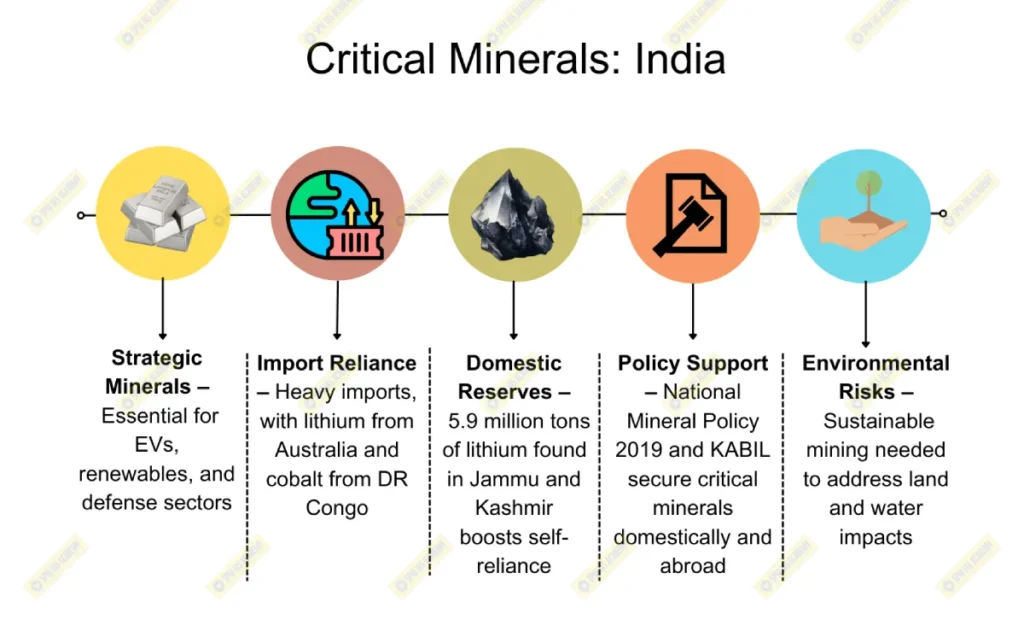The recent discovery of 5.9 million tons of lithium reserves in Jammu and Kashmir’s Salal-Haimana area marks a transformative moment for India’s energy and technology sectors. As a critical mineral for electric vehicle (EV) batteries, renewable energy storage, and electronic devices, lithium is essential for India’s transition to clean energy and for achieving self-reliance in strategic minerals. This discovery aligns with India’s goals under the Atmanirbhar Bharat initiative, positioning the country to reduce its dependency on imported lithium, which currently comes mostly from Australia, Chile, and Argentina.
Key Implications of the Lithium Discovery

1. Boost to India’s EV and Battery Manufacturing
The discovery strengthens India’s EV ambitions, as lithium is essential for lithium-ion batteries used in EVs. With the National Electric Mobility Mission Plan (NEMMP) 2020 aiming to deploy 6–7 million EVs annually, domestic lithium could significantly reduce battery costs, which constitute up to 40% of EV costs. It supports the FAME II scheme by making EVs more affordable, encouraging mass adoption.
2. Energy Security and Reduction in Import Dependency
India currently imports nearly 100% of its lithium. This discovery can lower dependency on global lithium supply chains and improve energy security. As per the NITI Aayog, India’s lithium demand could reach 20,000 tons by 2030; local reserves can make India self-reliant, reducing risks from fluctuating global prices and supply bottlenecks.

3. Economic Growth and Employment in Jammu and Kashmir
The lithium reserves are likely to spur economic development and create employment opportunities in Jammu and Kashmir, which has traditionally been economically isolated. Enhanced mining activity could lead to investments in local infrastructure, education, and healthcare. The Ministry of Mines estimates that mining and allied industries could bring substantial revenue to the region.
4. Geopolitical Leverage and Strategic Positioning
As a nation with lithium reserves, India could enter the league of lithium-rich countries, enhancing its geopolitical influence. This could provide India with bargaining power in international markets and strengthen partnerships with countries aiming for a sustainable energy future. It aligns with India’s Act East Policy by potentially collaborating with lithium-importing nations in ASEAN and beyond.
5. Environmental and Regulatory Challenges
Lithium mining poses environmental challenges, such as soil degradation, water scarcity, and ecosystem impacts. The Kasturirangan Committee on Environmental Reforms underscores the need for sustainable mining practices to minimize environmental damage. India will need to establish strict regulatory frameworks and adopt sustainable extraction methods to balance economic gains with environmental protection.
6. Catalyst for Renewable Energy and Storage Solutions
Lithium is pivotal for energy storage systems that stabilize power from renewable sources like solar and wind. The National Solar Mission and National Wind Mission aim for large-scale renewable installations by 2030, which require reliable storage solutions. Domestic lithium can bolster grid stability and facilitate higher renewable integration, essential for India’s Net Zero by 2070 goal.
The discovery of lithium reserves in Jammu and Kashmir is a strategic asset for India’s energy independence, economic growth, and environmental goals. While it offers economic and geopolitical advantages, the extraction and utilization must be managed sustainably to avoid environmental degradation. With effective policies, investment in technology, and international collaborations, India can leverage this resource for its clean energy transition and establish itself as a significant player in the global lithium economy. This discovery is a step forward in securing India’s future in the green economy, fostering regional development, and aligning with global climate commitments.











